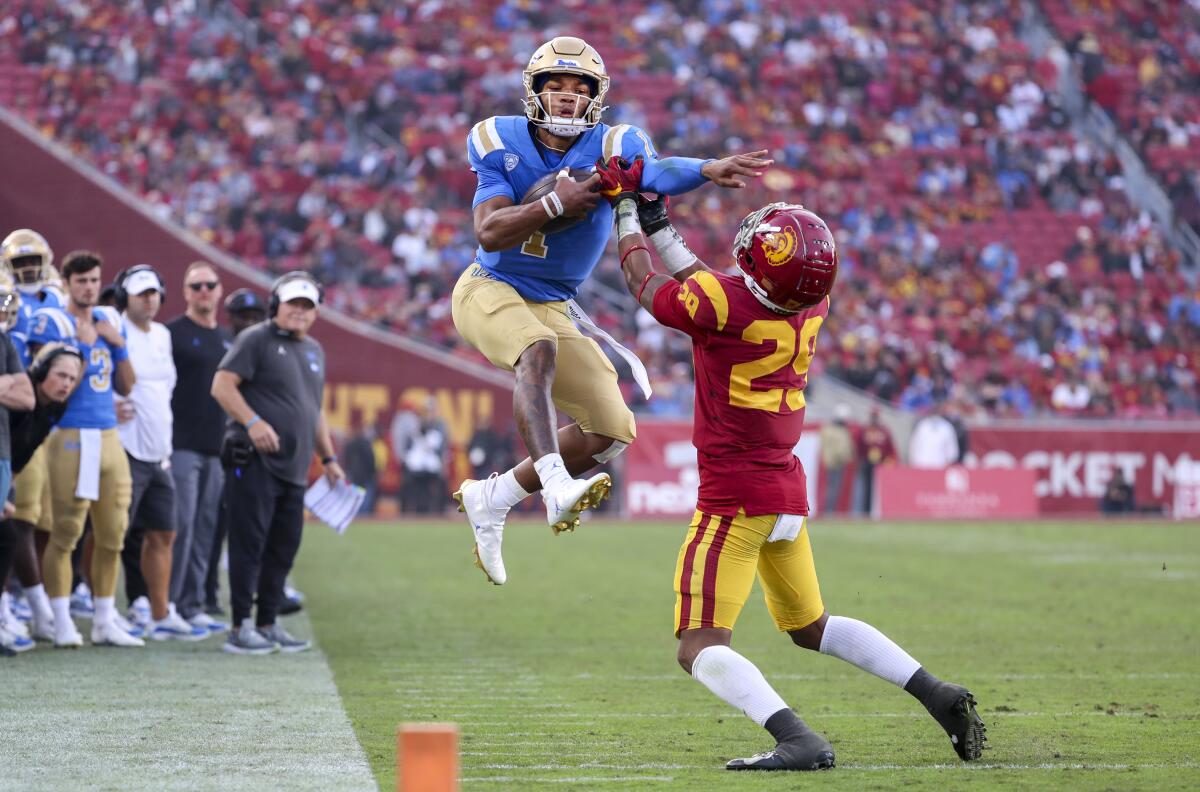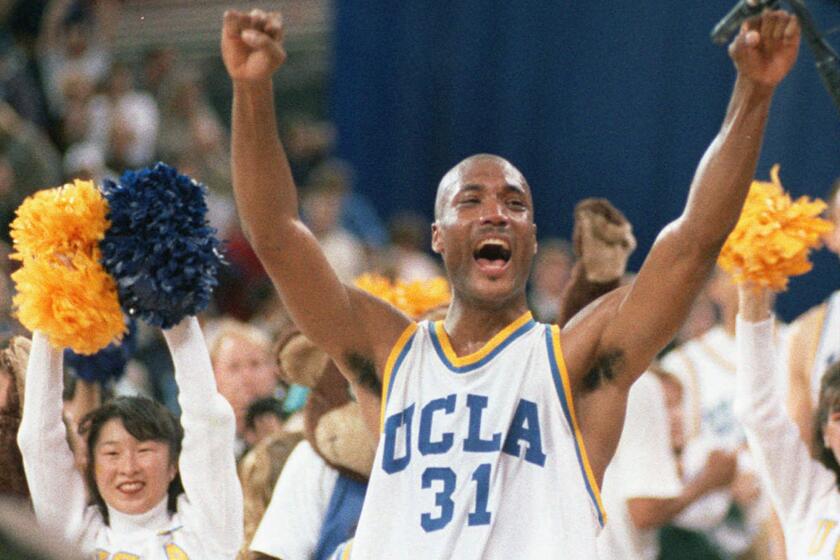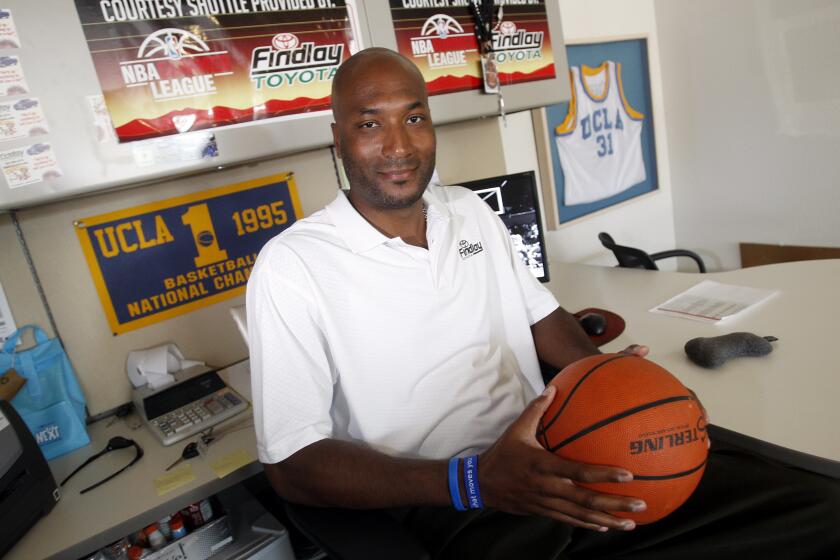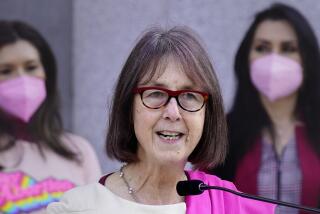Player advocates petition NLRB to make USC and UCLA classify athletes as employees

- Share via
California once again became a battleground in the fight for college athlete rights on Tuesday when the Corona-based National College Players Assn. filed unfair labor practice charges with the National Labor Relations Board against USC, UCLA, the Pac-12 Conference and the NCAA.
The action — led by longtime athlete advocate Ramogi Huma, a former UCLA football player and the NCPA executive director — comes more than two years after California passed the first-of-its-kind name, image and likeness (NIL) legislation. College athletes nationally have been able to profit from the use of their NIL since July 1, and Huma’s hope is that a favorable pro-athlete climate in California will continue to spur meaningful change, this time by affirming employee status for all Football Bowl Subdivision players and Division I men’s and women’s basketball players.
A win for the NCPA also would mean the death of the term “student-athlete” when applied to these three revenue-producing sports.
“One pivotal effect will be bringing forth free-market wages,” Huma told The Times. “When you’re an employee, schools won’t be able to cap compensation like they do. Leagues can’t cap compensation without a congressional exemption from antitrust law or a collective bargaining agreement. That would be a major development.”
After the groundbreaking events of last summer — the U.S. Supreme Court’s favorable ruling toward college athletes in Alston v. NCAA and the beginning of the NIL era — NLRB general counsel Jennifer Abruzzo wrote a memo stating she views college athletes as school employees under the National Labor Relations Act.
College athletes are about to be compensated for their fame because of a movement started in California by Nancy Skinner, Ed O’Bannon and others.
“Players at academic institutions perform services for institutions in return for compensation and subject to their control,” Abruzzo said. “Thus … certain players at academic institutions are statutory employees, who have the right to act collectively to improve their terms and conditions of employment. My intent in issuing this memo is to help educate the public, especially players at academic institutions, colleges and universities, athletic conferences, and the NCAA, about the legal position that I will be taking regarding employee status and misclassification in appropriate cases.”
Abruzzo’s memo helped give Huma the green light to file charges at the NLRB field office in L.A., naming USC and UCLA as single employers. Since the NLRB does not have jurisdiction over public institutions, Huma included the privately-held Pac-12 and NCAA as joint employers.
Of course, to enact change to the structure of college sports at a national level, public schools would have to be included in any ruling. Huma’s position is that UCLA and other public schools would fall under jurisdiction as a member of their conference and the NCAA.
Tuesday afternoon, USC released a statement that read, “College athletics at USC is part of the comprehensive set of opportunities we offer students as part of their educational experience, and we deeply value our talented students who participate in USC’s athletic programs. We always consider what is best for our students as individuals and support their success in many ways, including through scholarships and by providing academic and other support. We are aware of the charge and are reviewing it.”
The NCAA created the term “student-athlete” in the 1950s to avoid paying workers compensation to players. For the last 70 years, the schools that make up the association have vehemently fought to keep athletes from being classified as employees, which would allow them to pursue a larger cut of the revenues than they currently get.
Ed O’Bannon Jr. spearheaded the NCAA’s name, image and likeness movement but says in a first-person piece for the Los Angeles Times that ‘the baton has been passed.’
NIL became palatable after dozens of states passed laws similar to California’s because payments would come from third parties, not the schools, allowing the college system to function overall as it always has.
In 2014, Northwestern football players, aided by Huma’s guidance, filed similar charges with the NLRB field office in Chicago. The regional office affirmed the players’ right to unionize, but the national office declined to assert its jurisdiction.
Because of Abruzzo’s memo and changing attitudes from the Supreme Court to the halls of Congress to the court of public opinion, this NCPA filing could spur momentum.
“College athletes in America have been exploited for generations now, and it’s about time they even the playing field,” said Tony Cardenas, the U.S. representative from California’s 29th district. “The people who are giving the most are getting the least, while the NCAA collects billions of dollars yearly.”
Said Huma, “Fairly compensating FBS football and Division I basketball players is a matter of economic justice for all of these athletes, and it’s a matter of racial justice in these three sports. Black athletes make up a majority of these rosters and face a disparate impact from NCAA sports’ illegal compensation prohibition. This is both a labor rights issue and a civil rights issue.”
More to Read
Go beyond the scoreboard
Get the latest on L.A.'s teams in the daily Sports Report newsletter.
You may occasionally receive promotional content from the Los Angeles Times.













